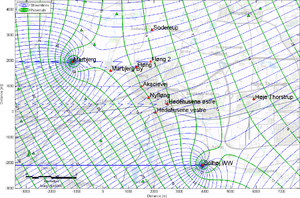Difference between revisions of "Modeling tools"
m (→Aqtesolv) |
m (→Comsol Multiphysics) |
||
| Line 4: | Line 4: | ||
Their capabilities with respect to modeling flow and transport in fractured media are compared in the chapter [[ Comparison of capabilities ]]. | Their capabilities with respect to modeling flow and transport in fractured media are compared in the chapter [[ Comparison of capabilities ]]. | ||
| − | === | + | === COMSOL Multiphysics === |
| + | |||
| + | COMSOL Multiphysics® is a general-purpose software platform, based on advanced numerical methods, for modeling and simulating physics-based problems. | ||
| + | It provides physics-based interfaces (e.g. a module for subsurface flow) and allows equation-based modeling, where arbitrary partial differential equations can be solved. | ||
| + | Different physics can be coupled. | ||
| + | The toolbox provides tools for mesh generation, a frontend for the simulation setup, several solvers and post-processing tools. | ||
| + | Discretization methods etc. | ||
| + | |||
| + | More details can be found on the COMSOL webpage: | ||
* [https://www.comsol.dk Comsol Multiphysics] | * [https://www.comsol.dk Comsol Multiphysics] | ||
Revision as of 12:32, 19 April 2016
Contents
Modeling tools
The following list shows some selected modeling tools that can be used for the simulation of fracture flow and transport. Their capabilities with respect to modeling flow and transport in fractured media are compared in the chapter Comparison of capabilities .
COMSOL Multiphysics
COMSOL Multiphysics® is a general-purpose software platform, based on advanced numerical methods, for modeling and simulating physics-based problems. It provides physics-based interfaces (e.g. a module for subsurface flow) and allows equation-based modeling, where arbitrary partial differential equations can be solved. Different physics can be coupled. The toolbox provides tools for mesh generation, a frontend for the simulation setup, several solvers and post-processing tools. Discretization methods etc.
More details can be found on the COMSOL webpage:
FEFlow
Hydrogeosphere
Useful helpers
Besides the comprehensive models, there are several small tools available that can be helpful when dealing with contaminant transport in limestone aquifers. Some will be described in the following.
Matlab model based on the semi-analytical algorithm presented in Christ and Goltz, 2002
Contaminated sites can often pose a threat to water suppliers. Christ and Goltz have developed a semi-analytical algorithm that allows estimating the capture zones of extraction wells. We have set up a simple Matlab model based on the algorithm from Christ and Goltz, which requires only a few parameters to estimate the capture zone of a production well. This can be very useful to get a quick estimate, if a contaminant is likely to flow towards a drinking water well, for example.
Required parameters
Following parameters are required to run the script:
- Estimate of the hydraulic conductivity
- Average hydraulic gradient of the natural groundwater flow
- Reference head at one point in the domain
- Direction of natural groundwater flow
- Aquifer thickness
- Location of wells
- Pumping rates
Furthermore, if a background map of the study area is available, the streamlines and isopotential lines can be directly plotted on the map, as shown in the example below.
Based on the paper by Christ and Goltz, J. Hydrology, 2002, p. 224-244. [1].
Matlab model for capture zone calculation
Aqtesolv
Aqtesolv is an easy-to-use tool for the design and interpretation of aquifer tests like pump tests and slug tests. It provides a bunch of conventional aquifer models for confined, leaky confined and unconfined aquifers and several advanced models, e.g. for fractured aquifers or oscillating water tables. A comprehensive description of the capabilities and a free demo version is available on the software's web page.
Return to Overview
